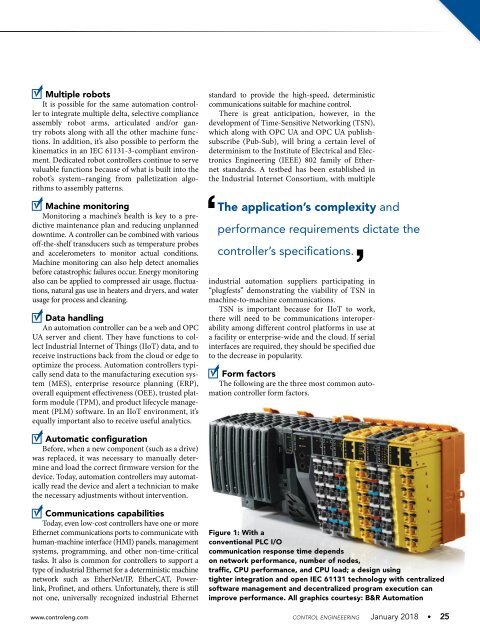Control Engineering - January 2018 (R) 'I'
Revista Control Engineering
Revista Control Engineering
Create successful ePaper yourself
Turn your PDF publications into a flip-book with our unique Google optimized e-Paper software.
• Automation experience of plant personnel<br />
• Number and type of I/O<br />
• Required control functions such as closed-loop<br />
proportional-integral-derivative (PID), motion,<br />
and speed<br />
• Communication options<br />
• Data collection requirements<br />
• Special function requirements.<br />
Some facilities are automation-savvy and can handle<br />
a wide range of controllers and equipment while<br />
others have limited familiarity with newer technologies.<br />
PLCs are the primary automation tool for many<br />
industries and applications because they provide<br />
accurate, reliable, and modifiable control while being<br />
easy to work with due to their widespread use and<br />
familiarity.<br />
If plant personnel are new to using PLCs, consider<br />
using a PLC that is small and simple. These controllers<br />
are designed for easy expansion while having many of<br />
the features present on larger PLCs.<br />
PLC selection, applications<br />
The next step is examining application requirements.<br />
A good starting point is to estimate the<br />
number of discrete and analog I/Os. A list of major<br />
components—along with position and presence sensors—will<br />
help determine an accurate count.<br />
In addition to discrete machine and analog process<br />
functions, some PLCs have evolved to perform<br />
complex tasks, such as motion and PID control. This<br />
type of controller can handle complex applications<br />
such as a high-speed packaging line using registration<br />
alignment.<br />
Servo and variable speed drives used for some<br />
motion control functions don’t always require coordination,<br />
but they still can be quite complex in terms of<br />
communication and other requirements. Many controllers<br />
can communicate to multiple drives at one<br />
time to command position, speed, or torque. RS-232,<br />
RS-485, Ethernet, and other options are all valid<br />
choices to communicate to drives. Choosing a digital<br />
communication protocol is a better choice compared<br />
to a discrete I/O because they simplify wiring, allow<br />
more parameters to be monitored and commanded,<br />
and is more flexible when changes are needed.<br />
Data collection requirements should also be considered.<br />
Fortunately, many controllers, even the new<br />
small PLCs, have built-in communications, data logging,<br />
web server access, and email capabilities. The<br />
ability to write data to micro SD cards is another feature<br />
worth having along with web server functionality<br />
and remote access.<br />
Some applications require safety ratings to meet<br />
regulatory requirements. While the application<br />
may suggest using a safety-rated PLC, using a nonsafety<br />
rated PLC along with one or more programmable<br />
safety relays can reduce costs while providing the<br />
functionality that is required.<br />
Evaluating software programming<br />
Software programming is about half the effort on<br />
a typical automation project, but the time required<br />
to program the controller and the required level of<br />
expertise can vary widely depending on the controller<br />
programming software. <strong>Control</strong>ler programming<br />
software considerations include:<br />
• Ease of programming<br />
• Preferences and comfort zone<br />
• Time and money investment<br />
• Available training resources<br />
• Data logging and remote access.<br />
Simple—and sometimes free—software with limited<br />
programming instructions covers most applications<br />
suitable to use with these small controllers. As<br />
machine size and complexity increases, most midsize<br />
and larger PLCs provide software platforms, which<br />
take longer to learn than their simpler counterparts.<br />
<strong>Control</strong>ler programming software choices often<br />
relate to a user’s preferences and comfort zone. While<br />
the hardware required is driven and determined by the<br />
application requirements, software selection is usually<br />
a subjective decision. Most companies should enforce<br />
a standard controller programming software platform<br />
along with consistent programming methods.<br />
Users should consider training resources that<br />
are available when selecting programming software.<br />
There are huge libraries of technical information and<br />
user manuals exist online.<br />
Once the software program is developed, it needs<br />
to be tested. The programming software should<br />
include the ability to view a PID loop response and<br />
motion profiles and to simulate other software functionality.<br />
Built-in project simulators can be a huge<br />
timesaver by allowing code to be tested without the<br />
hardware present or before being downloaded to an<br />
existing system.<br />
While there are many considerations for selecting<br />
the right hardware and programming software<br />
for a controller, it’s unlikely there’s a “one size fits all”<br />
approach to selecting a controller. It’s better to pick a<br />
family of controllers capable of handling a company’s<br />
range of requirements. ce<br />
Jeff Payne is an automation controls group product<br />
manager at AutomationDirect. Edited by Emily<br />
Guenther, associate content manager, <strong>Control</strong> <strong>Engineering</strong>,<br />
CFE Media, eguenther@cfemedia.com.<br />
‘<br />
In addition to<br />
discrete machine<br />
and analog<br />
process functions,<br />
some PLCs<br />
have evolved to<br />
perform complex<br />
tasks, such as<br />
motion and PID<br />
control.<br />
’<br />
M More<br />
ANSWERS<br />
KEYWORDS<br />
Programmable logic<br />
controllers (PLC),<br />
programmable automation<br />
controllers (PAC),<br />
industrial personal<br />
computer (IPC)<br />
How to choose a controller<br />
for particular applications<br />
Developing the controller’s<br />
software programming<br />
Proper testing methods for<br />
software programs.<br />
Research: see controller<br />
research results at www.<br />
controleng.com/ce-research.<br />
CONSIDER THIS:<br />
What is the most costeffective<br />
way to properly test<br />
and simulate the controller’s<br />
software program?<br />
www.controleng.com CONTROL ENGINEEERING <strong>January</strong> <strong>2018</strong> • 23


